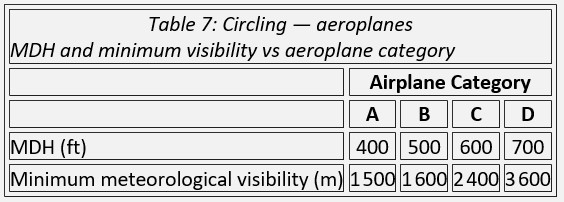Ops Part 2
- Anaqah Ismail
- Sep 23, 2019
- 4 min read
Updated: Sep 24, 2019
Commencement and continuation of approach
If the RVR/VIS < applicable minimum the approach shall not be continued;
below 1000' above the aerodrome
into final approach segment in the case where DA/H or MDA/H > 1000' above aerodrome
Minimum RVR for midpoint - 75m
The planning minima for a destination alternate with a CAT II approach is RVR according to CAT I.
The recent experience conditions of a captain assigned to a flight of an aircraft by an operator must not be less than; 3 take-offs, 3 landings as pilot at flight controls during last 90 days.
ANNEX 1 = definitions
ANNEX 2 = authority requirements for air operations
ANNEX 3 = organisation requirements for air operations
ANNEX 4 = commercial air transport operations
ANNEX 5 = specific approvals
ANNEX 6 = non-commercial air operations with complex motor-powered aircraft
ANNEX 7 = non-commercial air operations with other-than complex motor-powered
ANNEX 8 = specialized operations

Dry lease - you add the aircraft to your AOC (so it is under your responsibility)
Wet lease - the aircraft is still under the owner, you simply do whatever you need with the aircraft
Safety Management System for an AOC holder under EU 965/2012;
Management shall correspond to the size of the operator and nature, and complexity of activities, taking into account the hazards and associated risks inherent in these activities.
Cabin Crew at least 18 years of age
RNP type NM 95% flying time
An operator must ensure that system minima used for non-precision approach procedures are not lower than the MDH of NDB facility, 350'.
Max distance from an aerodrome for 2-engine aeroplanes without ETOPS approval;
Class A with
MOPSC 20 or more
MTOM 45360 kg or more
distance in 60 minutes with OEI
Class A with
MOPSC 19 or less
MTOM < 45360 kg
distance in 120 minutes up to 180 minutes OEI
Class B or C with
distance in 120 minutes at OEI or 300 NM, whichever less

An operator must select a take-off alternate if it would not be possible to return to the aerodrome of departure for meteorological or performance reasons
Manuals to be carried on board aircraft; relevant parts of the ops manual and AFM (Aircraft Flight Manual = approved by authority)

The MDH (minimum descent height) should not be lower than the highest of;
published circling OCH (obstacle clearance height)
min circling height from table 7
DH/MDH of preceding instrument approach procedure
On board a pressurized aircraft, all crew members to be supplied with oxygen in the event of cabin depressurization, during which Pressure Altitude > 13000'
Safety manager = key post holder
Night Duty = between 0200 to 0459
Personnel records about crew member recent experience is stored for 15 months
Operator ensures mass and balance documentation is stored for a minimum period of 3 months
Certificate of Registration (Original)
Certificate of Airworthiness (Original)
Certificate of Noise (Original)
Air Operative Certificate (Copy)
Aircraft Radio License (Original)
Third Party Insurance (Copy)

Cabin Oxygen masks (dispensing units) at least 110% of seating capacity
For a pressurized aeroplane, to fly more than 25000' all occupants of flight deck seats shall be supplied with supplemental oxygen not less than 2 hours
When refueling is being conducted with passengers embarking or disembarking, communications shall be maintained by ground crew and qualified crew on board
1 cabin crew for every 50, or fraction of 50, passenger seats installed on same deck of aeroplane
Following an accident involved with dangerous goods, an operator has 72 hours to report to authority.
For single pilot operations under IFR and night, AUTOPILOT must be capable of holding at least altitude and heading
Operation Manual = general information, instructions, recommendations on transport of dangerous goods

Operator ensures (when conducting LVOs) training of crew encompasses taxiing, take-off, approach, flare, hover, landing, roll-out, missed approach

Emergency Medical kits = must be kept in under secure conditions, either in flight crew compartment or in another locked compartment

Aircraft with a certificated MTOM of 232000 kg and certificated too carry 350 passengers requires 1 crash axe or crowbar on flight deck, and one crash axe or crowbar in rear galley.
Minimum required recent experience for a pilot engaged in a single-pilot operation under IFR; 5 IFR flights, including 3 instrument approaches, carried out during preceding 90 days on the type or class of aeroplane in the single-pilot role.
Considering a flight within RVSM airspace, upper limit of threshold for altitude deviation alerting equipment +/- 90 m (+/- 300')
When MOPSC > 19 and MCTOM > 15000 kg, crew member gets interphone system
Proficiency checks 2 times a year, validity is 6 months.
3-month rule = you can update 3 months before your thing actually expires.
LINE flight = route flying
LINE check = once every 12 months
Experience by a pilot; 3 take-offs and 3 landings in the recent 90 days (but for some reason if cannot, then one sortie flown with either a type rating examiner or type rating instructor in a simulator will extend to 120 days)
Operator needs to provide the following information to authority for continued validity of AOC;
Official name, business name, address, and mailing address of applicant
Name of accountable manager
Type(s) and number of aircraft to be operated
Single pilot flying at night (Conditions to be met)
5 IFR take-offs and 3 precision approaches in the last 90 days
50 hours with at least 10 hours under IFR (included)
PIC (Co-pilot requirements)
A cruise Captain is a Captain that does not takeover controls below 21000' (pilots who relieve the copilot and captain) should hold a valid ATPL and should be qualified on type. And he should be current and competent for route flying
A cruise Copilot should hold a valid CPL, IR and route competence must be checked and he must be current.
CREW COMPOSITION
IFR at night
Passenger seats > 9
Minimum of 2 pilots (turbojet/turboprop)
2 pilots must be current, carried out conversion = 3 landings, 3 T/Os in last 90 days
Relief crew
Cabin crew
Passed class 2 medical exam
At least 18
Duties given by Operator or Commander
If there's more than one cabin crew member, there must be a senior cabin crew, you need at least 1 year of experience as cabin crew.
For every 19 passenger seats, one cabin crew on one deck.
For every 50 members, you add one cabin crew.
The following is kept on the ground;
1) A copy of Operational Flight Plan
2) Copies of relevant part(s) of aircraft tech log
3) route-specific NOTAM documentation
4) Mass and Balance Documentation
5) Special Loads notification


Operational Flight plan is stored in an acceptable form for at least 3 MONTHS
Emergency Exits
Before 31 March 2000
Height above ground greater than 6', aeroplane on ground, landing gear extended
After 31 March 2000
Height above ground greater than 6', aeroplane on ground, one or more legs of the landng gear collapsed


Comments